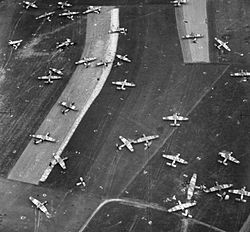| Operation Mallard | |||||||
|---|---|---|---|---|---|---|---|
| Part of the Normandy landings | |||||||
 Landing zone 'N' 7 June 1944 | |||||||
| |||||||
| Belligerents | |||||||
|
|
| ||||||
| Commanders and leaders | |||||||
|
|
| ||||||
| Units involved | |||||||
| 6th Airborne Division |
716th Infantry Division 21st Panzer Division | ||||||
Operation Mallard was the codename for an airborne forces operation, which was conducted by the British Army on 6 June 1944, as part of the Normandy landings during the Second World War.
The objective was to airlift glider infantry of the 6th Airlanding Brigade and divisional troops to reinforce the 6th Airborne Division on the left flank of the British invasion beaches. Using two landing zones, one to the west of the Caen canal and the other to the east of the River Orne, Mallard was the third airborne operation involving units of the division on D-Day. The first of the Caen canal and Orne river bridges to be captured, were what are now known as the Pegasus Bridge and Horsa Bridge. Operation Tonga followed, dropping the division's two parachute brigades near Caen to the east.
Mallard proved successful with 246 of the 256 gliders towed by aircraft from No. 38 Group RAF and No. 48 Group, arriving safely at their landing zones.[1] The landings included the first Tetrarch tanks to be delivered into combat by air.
© MMXXIII Rich X Search. We shall prevail. All rights reserved. Rich X Search
